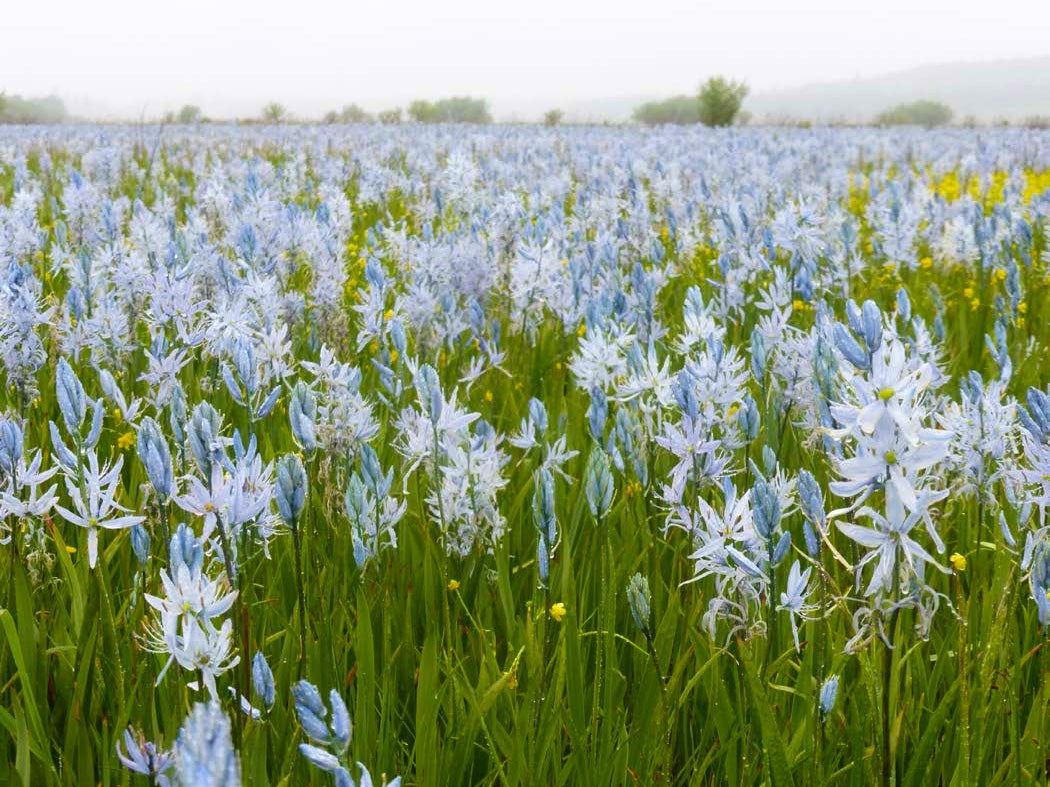Last updated: December 12, 2018
Article
Camas Citizen Science Monitoring Program
The Camas Citizen Science Monitoring Program was developed by the National Park Service Upper Columbia Basin Network (UCBN) Inventory and Monitoring Program in collaboration with Nez Perce National Historical Park. The Camas Citizen Science Program is part of a national initiative to monitor vital signs, or selected ecological indicators representing the overall health or condition of park resources. Camas lilies was chosen as a vital sign at Nez Perce National Historical Park’s Weippe Prairie site (Idaho) and Big Hole National Battlefield (Montana) because of their value as both a cultural and natural resource.

NPS
This project seeks to engage high school volunteers as "Citizen Scientists" in the long range scientific monitoring of camas lily populations. Students are trained in the classroom and then spend time in the field using data collection techniques specifically designed for this program. Results of the monitoring effort are available to National Park Service managers so that they can make better management decisions based on sound, scientific information.
Learning components of the program are tied to state science standards, and students work alongside ecologists, statisticians, natural resource managers, and interpretive rangers. This is a unique learning opportunity that students are sure to remember.

NPS / Devin Stucki
Why Monitor Camas Populations?
Camas is an important cultural and natural resource. For the last 7,000 years, camas has been an important part of the Nez Perce history, life and culture, as well as those of many other tribes of the Pacific Northwest. The tradition of gathering, preparing and eating camas is part of a living culture that is passed down from one generation to the next. In addition, camas is one of a suite of wetland species associated with seasonal wet prairie ecosystems. Wetlands perform an important role in the local water cycle. They store and release water slowly, assisting in recharging water tables and providing habitat for wildlife. However, as a result of recent agricultural conversion, irrigation, flood control, and other land use practices, remaining wet prairies in this region have been drastically reduced. Recent climate change will also impact these wet prairie ecosystems and monitoring camas populations will provide the National Park Service an opportunity to track climate change impacts on park natural resources.
Camas constitutes an important cultural and natural resource in this region and is an indicator species that can provide information on the overall health of the wetlands at Nez Perce National Historical Park’s Weippe Prairie site and Big Hole National Battlefield. Both sites honor the Nez Perce tribe and preserve the story of how this group of people lived as part of this landscape.
Who is Involved?

NPS
Students from three local high school have been collecting camas lily data for the past six years at Nez Perce National Historical Park’s Weippe Prairie Site. The program is divided into two parts:
- A pre-visit training, where staff from Nez Perce National Historical Park visit the schools and provide information and training to the students. During these visits students receive:
- Cultural information on camas and its importance
- Background lessons on camas ecology/Earth System Science
- Training on the use of Global Positioning Systems (GPS) and compasses to determine plot location and direction
- Field work time (1 day), where students from each school participate in about 3 to 6 hours of data collection. During the field trip students:
- Work in small groups with park scientists and interpretive staff to collect data
- Put in practice what they have learned in the classroom by using GPS, compass, and field equipment
- Establish plots, or quadrats, for measuring camas density
- Collect data on flowering and non-flowering camas plants and the presence of invasive species
- Record data using handheld computers
Students have had the opportunity to interact with park staff and scientists by collecting scientific data, participating in an educational service project, and using technology while learning about this important resource. They also have assisted in collecting invasive weed information.
Monitoring of camas and invasive weeds is a unique opportunity to integrate natural resource monitoring with the cultural history of the Nez Perce people and to provide an unparalleled educational citizen science opportunity for community members of all ages.
Other Resources
The National Park Service has developed a set of lessons on invasive weeds that correlate to most middle school science curricula and many are easily adapted to elementary or high school grades. Throughout this curriculum guide, links are provided to give teachers and students additional background information and resources for in-depth studies.
Source: NPS DataStore Saved Search 884 (results presented are a subset). To search for additional information, visit the NPS DataStore.
Source: NPS DataStore Saved Search 712. To search for additional information, visit the NPS DataStore.
Source: NPS DataStore Saved Search 732. To search for additional information, visit the NPS DataStore.
For More Information
Contact: Heidi Becker
